Two decades of functional–structural plant modelling: at the crossroads (Review)
Annals of Botany 126: 501–509, 2020
doi: 10.1093/aob/mcaa143
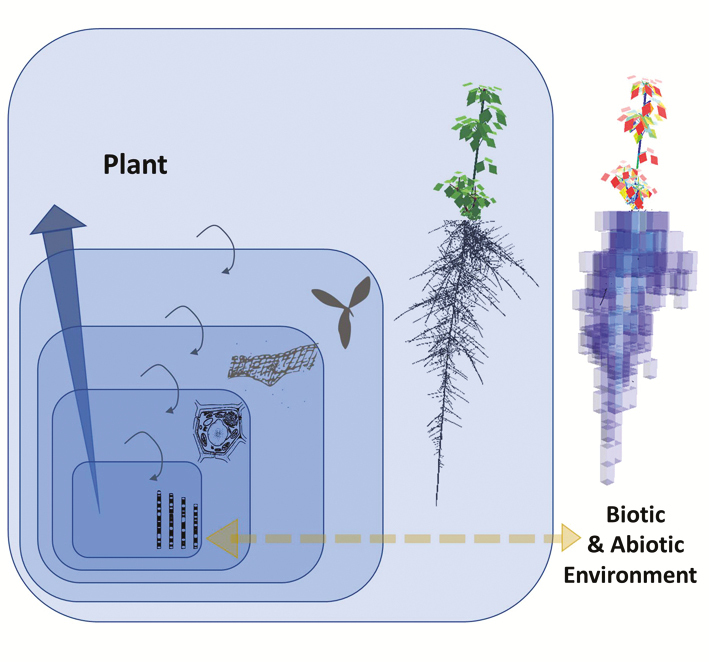
Functional–structural plant models explore and integrate relationships between a plant’s structure and processes that underlie its growth and development. Louarn and Song discuss the models presented in this issue and conclude that FSP models now cover a range of scale integration from gene to community levels. The focus of attention now is the explanation of how plant phenotypes at different scales are built from interactions with their inner (including genetic determinants and self-regulation loops expressed at various levels) and outer (including abiotic factors and biotic interactions in plant populations and communities) environments.
Authors: Gaëtan Louarn and Youhong Song
Photosynthesis: basics, history and modelling (Review)
Annals of Botany 126: 511–537, 2020
doi: 10.1093/aob/mcz171
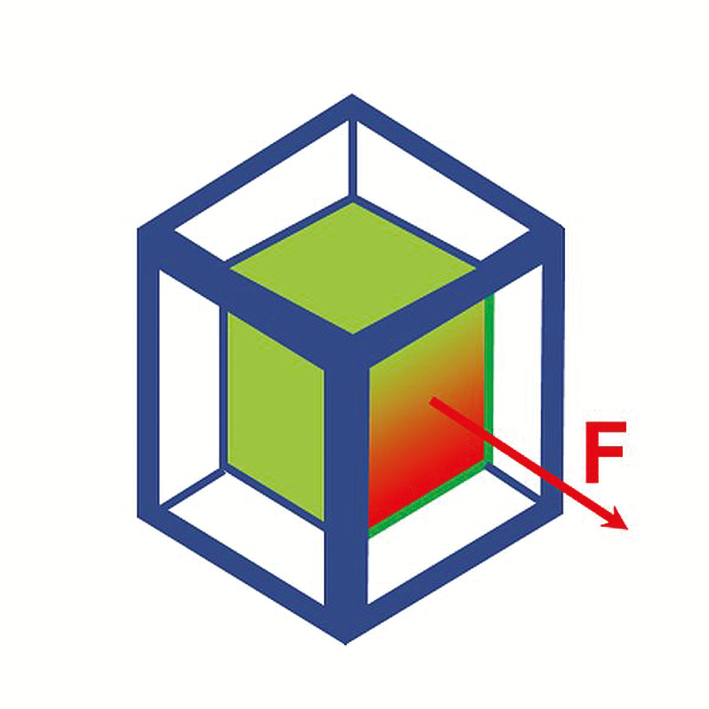
With limited agricultural land and increasing human population, it is essential to enhance overall photosynthesis and productivity. Stirbet et al. discuss some of the discoveries related to photosynthesis in plants, algae and cyanobacteria, and show that mathematical modelling is a highly valuable tool in understanding this process. Different mathematical models have been used to examine theories on diverse photosynthetic mechanisms, which have been validated through simulation(s) of experimental data, such as chlorophyll fluorescence (F) induction. They also emphasize the important role of modelling in untangling complex photosynthesis processes, and in predicting possible ways to obtain higher biomass and productivity in plants, algae and cyanobacteria.
Authors: Alexandrina Stirbet, Dušan Lazár, Ya Guo, and Govindjee Govindjee
Agent-based models in plant biology and ecology (Review)
Annals of Botany 126: 539–557, 2020
doi: 10.1093/aob/mcaa043
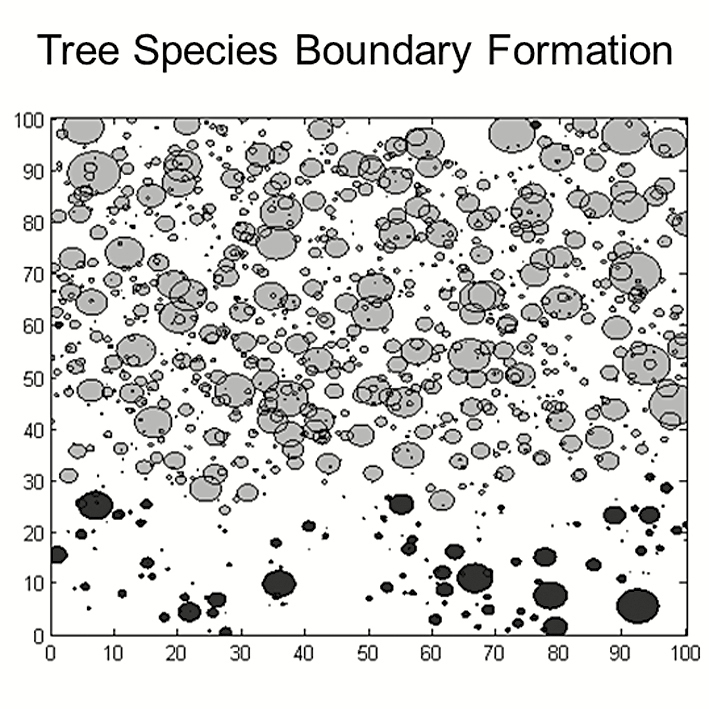
Agent-based plant population models (ABMs) are used to simulate the dynamics of populations and communities by following the life cycle and interactions of each individual plant, while functional–structural plant (FSP) models are ABMs simulating how the growth of individual plants arising from interactions of smaller units, metamers. Zhang and DeAngelis review these models as forming a continuum across both spatial scales and levels of detail. The purposes of ABMs range from predicting light interception and fruit production of individual plants to patterns of plant.
Authors: Bo Zhang and Donald L. DeAngelis
Pattern-oriented calibration of FSP models (Technical Article)
Annals of Botany 126: 559–570, 2020
doi: 10.1093/aob/mcaa016
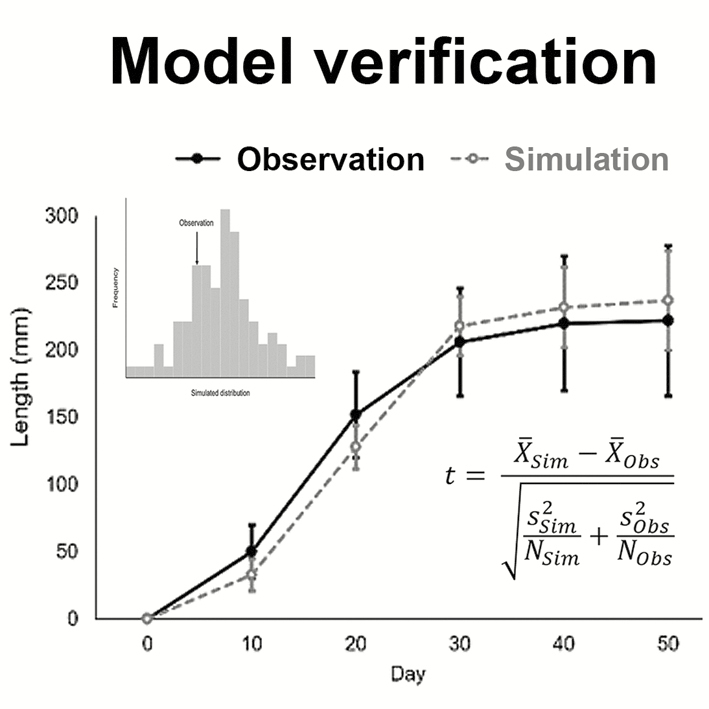
Parameterization of functional–structural plant (FSP) models is challenging. Wang et al. therefore use pattern-oriented modelling (POM) to make this process more systematic, efficient and powerful. An existing model was used to check whether POM calibration would converge to the manually calibrated set and to test model predictive power. The model was run for 10,000 sub-sampled parameter sets. Each verification pattern was used for rejecting unrealistic sets under specified criteria. They then used surviving sets for model validation and/or application. Such a simulation inference technique allows FSP models with increased predictive power to be developed in a timely manner, when data are scarce.
Authors: Ming Wang, Neil White, Jim Hanan, Di He, Enli Wang, Bronwen Cribb, Darren J. Kriticos, Dean Paini, and Volker Grimm
MuSCA multi-scale carbon allocation model
Annals of Botany 126: 571–585, 2020
doi: 10.1093/aob/mcz122
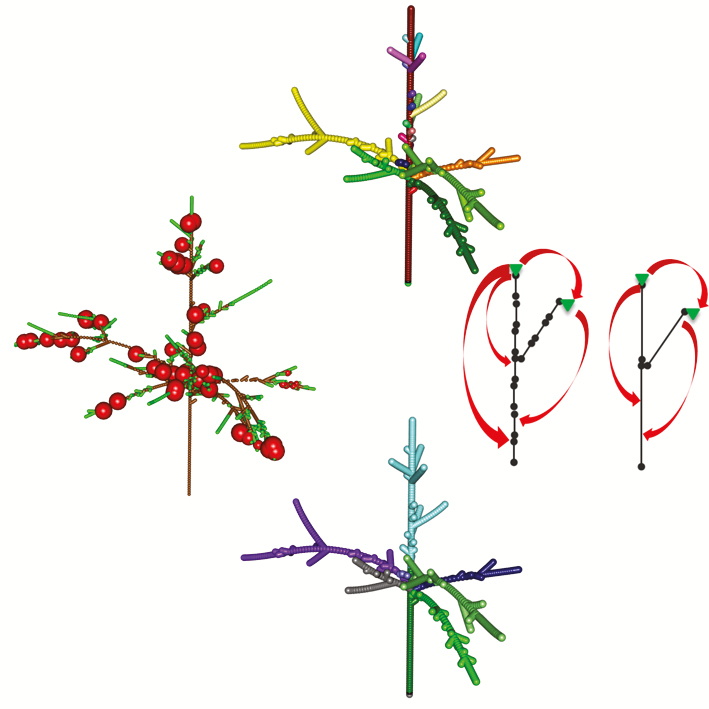
Carbon allocation models represent plants at specific topological scales, a reason why results obtained by different models are difficult to compare. Reyes et al. develop a source-sink, Multi Scale Carbon Allocation model (MuSCA) that allows different, user-defined, topological scales of a plant. Models satisfactorily represented effects of competition for carbon and multi-scale consistency on three realistic apple tree structures. MuSCA was useful in assessing the impact of the scale of representation depending on the tree structure considered and the trade-offs between computation time and prediction accuracy.
Authors: F. Reyes, B. Pallas, C. Pradal, F. Vaggi, D. Zanotelli, M. Tagliavini, D. Gianelle, and E. Costes
Modelling the contribution of bent shoots to cut-rose production
Annals of Botany 126: 587–599, 2020
doi: 10.1093/aob/mcz150
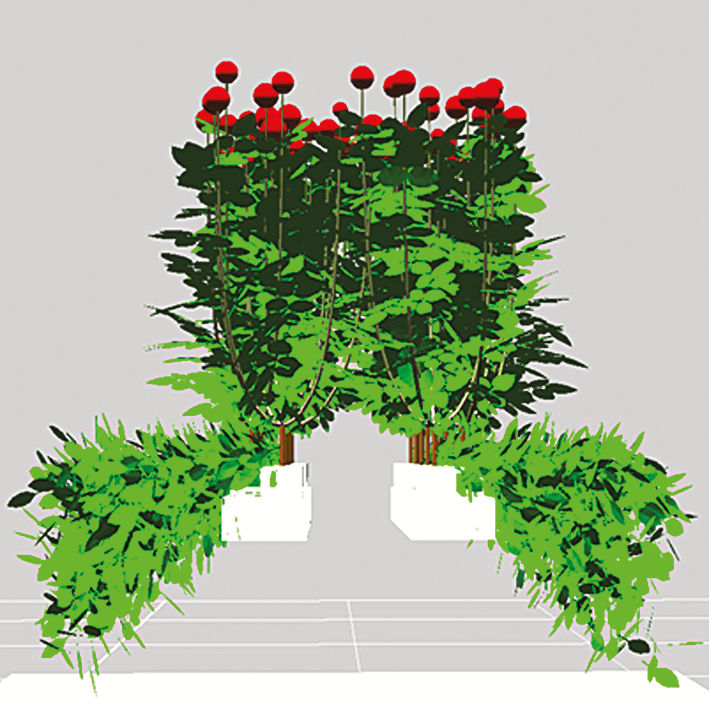
Shoot bending is a common practise used in cut-rose production to improve flower shoot quality. To optimize the number of bent shoots, Zhang et al. use a functional–structural plant (FSP) model to quantify the contribution of bent shoot photosynthesis to flower shoot growth. Their model simulations reveal that the increased flower shoot dry weight in plants that had bent shoots can entirely be attributed to the additional photosynthesis by bent shoots. FSP modelling can also be applied to optimize production of other crops with heterogeneous canopy structure.
Authors: Ningyi Zhang, Arian van Westreenen, Jochem B. Evers, Niels P. R. Anten, and Leo F. M. Marcelis
Decomposition analysis of gross primary productivity (GPP)
Annals of Botany 126: 601–614, 2020
doi: 10.1093/aob/mcz163
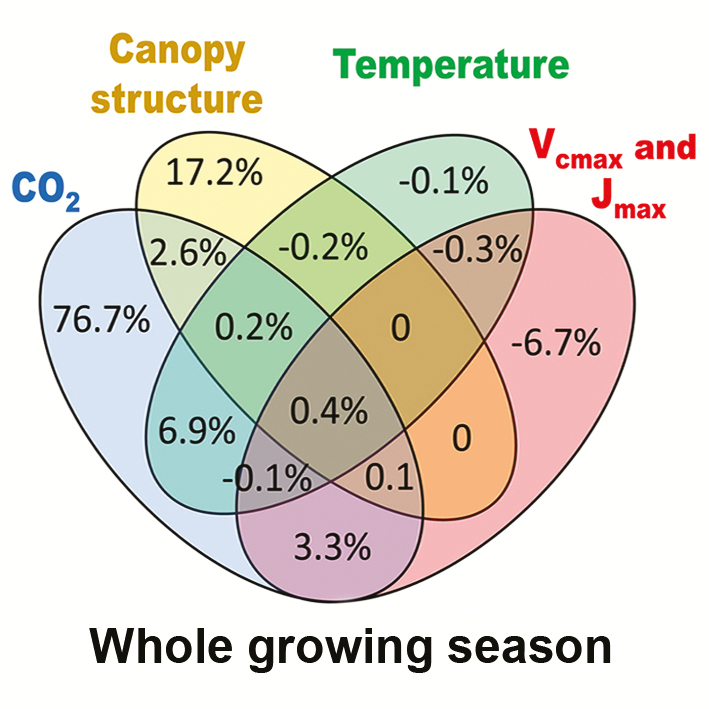
Understanding how climate change influences crop productivity helps in identifying new options for increasing crop productivity. A Soybean 3D canopy model was built to dissect the contribution of different factors on gross primary productivity (GPP) under elevated CO2. Song et al. show that both CO2 fertilization effect and changes in canopy architecture contribute to a large increase in GPP, while acclimation in photosynthesis to elevated CO2 and altered leaf temperature played a minor role in the changes in GPP. They also show that there is a synergestic effect of CO2 and light on crop growth under elevated CO2 conditions.
Authors: Qingfeng Song, Venkatraman Srinivasan, Steve P. Long, and Xin-Guang Zhu
Contrasting maize phenotypes simulated from stable co-ordination rules
Annals of Botany 126: 615–633, 2020
doi: 10.1093/aob/mcz168
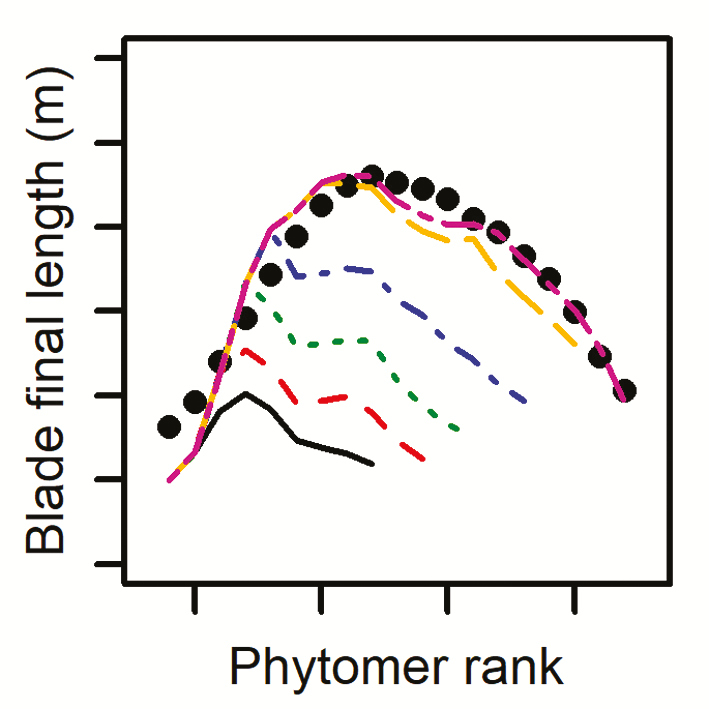
Plant shoots show robust patterns in both the size of successive organs and the rate of their appearance. The mechanisms underlying these patterns remain poorly understood. Vidal and Andrieu utilize experimental characterization of the dynamics of extension, in addition to modelling, to investigate the construction of the maize shoot. They find that contrasting observed phenotypes can be simulated by the same set of rules that coordinate the extension of successive phytomers. A few changes in the rules occur following tassel initiation with a major impact on the emerging pattern. These results have significant implications for building mechanistic models of the construction and plasticity of a grass shoot.
Authors: Tiphaine Vidal and Bruno Andrieu
Disentangling plant photosynthesis response to low PAR and low R:FR
Annals of Botany 126: 635–646, 2020
doi: 10.1093/aob/mcz197
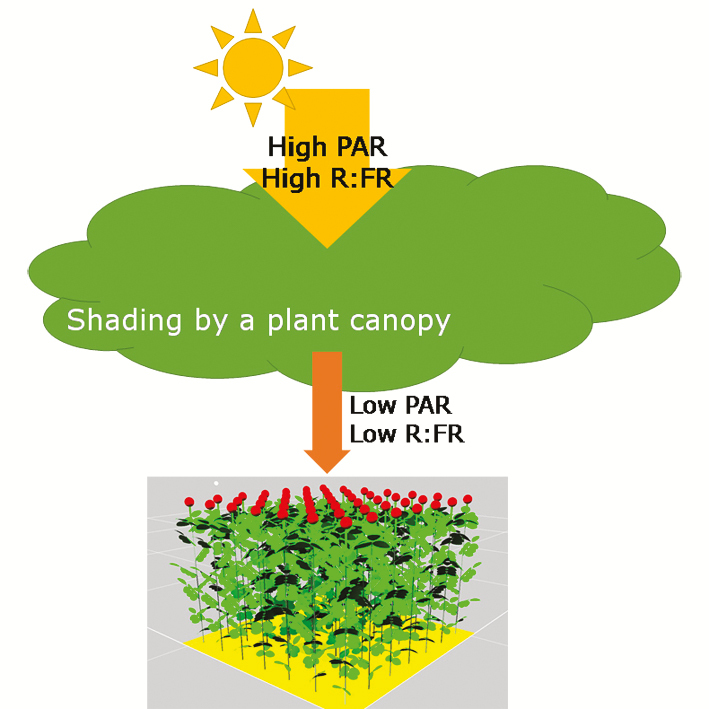
Shading by an overhead plant canopy entails reductions in both photosynthetically active radiation (PAR) and red to far-red light ratio (R:FR). Simulations by Zhang et al. show that trait responses to R:FR were more important for plant photosynthesis under mild canopy shading, whereas trait responses to PAR were more important under heavy shading. Moreover, simulations reveal interactions between effects of individual trait responses on plant photosynthesis, suggesting that the adaptive significance of plant plasticity responses to one shading factor depends on plant responses to the other.
Authors: Ningyi Zhang, Arian van Westreenen, Niels P. R. Anten, Jochem B. Evers, and Leo F. M. Marcelis
A 3D model simulating whole plant gas-exchange for grapevine
Annals of Botany 126: 647–660, 2020
doi: 10.1093/aob/mcz203
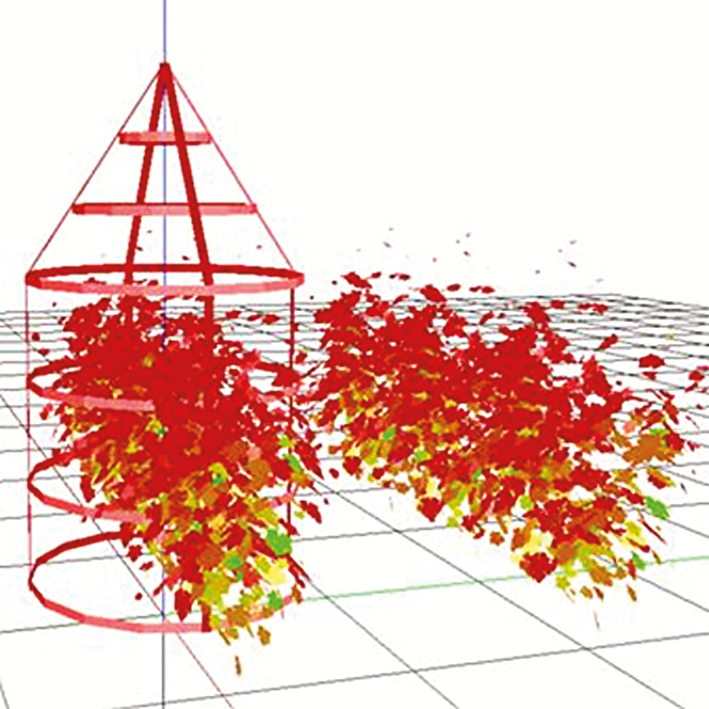
Scaling from leaf to whole canopy photosynthesis faces several complexities related to variations in leaf properties. To evaluate the impact of grapevine training systems on gas exchange, Prieto et al. develop a functional–structural plant (FSP) model that combines models for 3D reconstruction of canopy architecture, light interception and gas exchange. Whole plant gas-exchange was measured to validate the model with data collected on different training systems. The model accurately reproduces the daily pattern of gas-exchanges of plants trained under contrasting systems. FSP modelling appears as a reliable tool for evaluating the impact of a grapevine training system on water use efficiency at the plant level.
Authors: Jorge A. Prieto, Gaetan Louarn, Jorge Perez Peña, Hernán Ojeda, Thierry Simonneau, and Eric Lebon
Effect of leaf shape simplifications on 3D light modelling
Annals of Botany 126: 661–670, 2020
doi: 10.1093/aob/mcz205
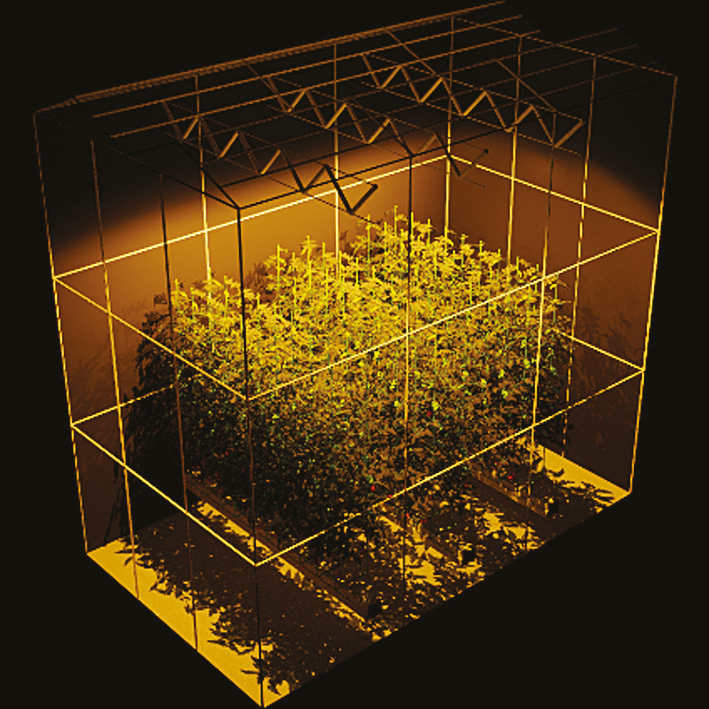
Functional–structural plant (FSP) models often resort to structural simplifications for highly irregular leaflet shapes such as in tomato. The effect this has on the simulated light distribution and photosynthesis in the model has not been previously addressed. Vermeiren et al. integrate realistic leaflets into static FSP models and compare them to previously used simplifications. While the cost of adding these realistic shapes was limited, small, but significant, differences were found to result from the simplifications, often in unpredictable patterns. The differences were further affected by canopy structure, external light conditions, photosynthesis, and the simplifactions used. The simplifications used. The magnitude [space] of the differences depends on the type of leaflet shape simplification as well as canopy shape and density. Assessment of cost–benefit of realistic shape inclusion shows relatively few drawbacks for a decrease in model uncertainty.
Authors: Jonathan Vermeiren, Selwyn L. Y. Villers, Lieve Wittemans, Wendy Vanlommel, Jeroen van Roy, Herman Marien, Jonas R. Coussement, and Kathy Steppe
Improving over-yielding in legume-based mixtures
Annals of Botany 126: 671–685, 2020
doi: 10.1093/aob/mcaa014
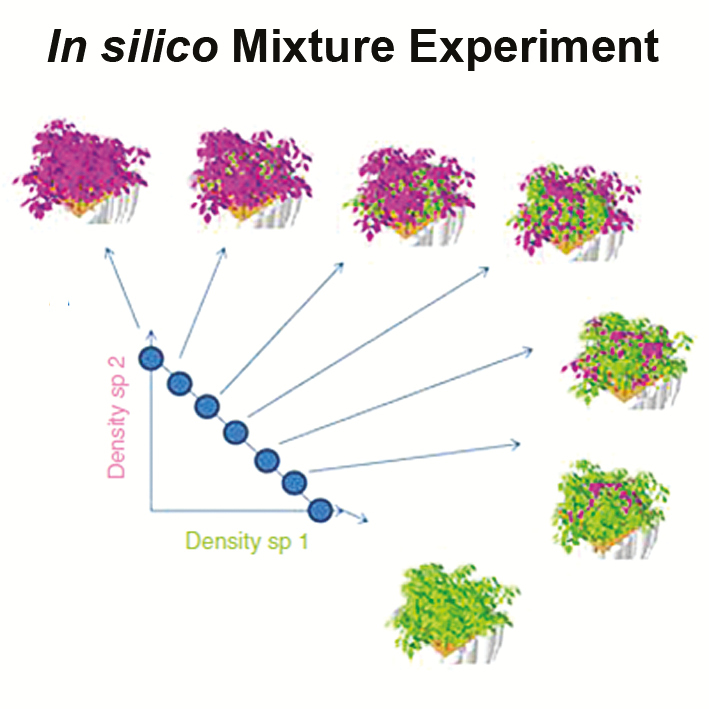
Louarn et al. use the functional–structural plant (FSP) model Virtual Grassland to assess how divergence in trait values between species on four physiological functions involved in carbon and nitrogen acquisition affect over-yielding and mixture stability in legume-based binary crop mixtures. The approach is able to infer major interaction traits with non-legume crops and could help to define ideotypes adapted to a targeted intercropping system.
Authors: Gaëtan Louarn, Romain Barillot, Didier Combes, and Abraham Escobar-Gutiérrez
Insights into trophic regulations from a stochastic plant growth model
Annals of Botany 126: 687–699, 2020
doi: 10.1093/aob/mcaa023
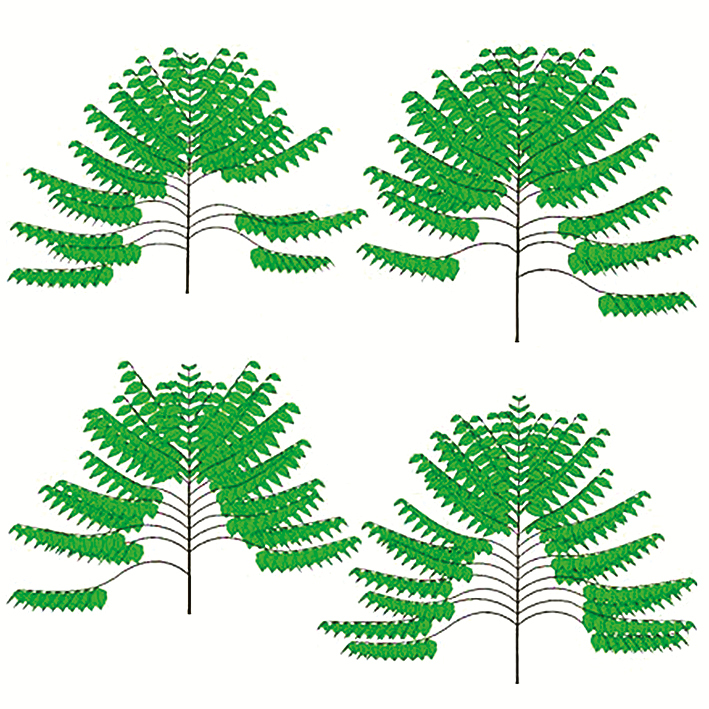
In functional–structural plant (FSP) models, using the ratio of biomass supply to demand as a regulator of plant development is an appealing hypothesis to simulate plant plasticity. This approach is however hampered by the fact that this non-measurable quantity cannot be easily estimated, especially when the model is stochastic. Letort et al. develop a parameter estimation procedure for the ‘GL4’ model, a self-regulating stochastic version of the GreenLab dynamic model. They applied it to young coffee trees (Coffea canephora, Rubiaceae) and found that a correlation between source-sink dynamics and organogenesis probabilities for young growth stages only.
Authors: V. Letort, S. Sabatier, M.P. Okoma, M. Jaeger, and P. de Reffye
Quantification of light interception within image-based 3-D canopies
Annals of Botany 126: 701–712, 2020
doi: 10.1093/aob/mcaa046
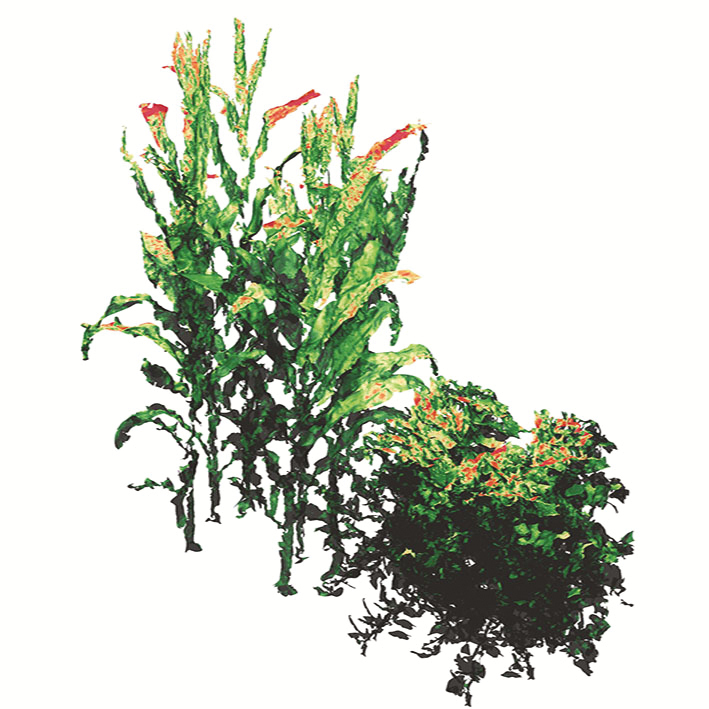
Understanding the relationship between light interception and canopy architecture is important for breeding and planting strategies. Zhu et al. present a high-resolution method that can be applied to single- and multi-species cropping systems to facilitate characterization of the light environment. The accurate reconstruction of 3D plants grown in field based on multi-view images method allows a better understanding of the relationship between canopy architecture and the light environment providing possibilities for high-throughput 3D phenotyping in the future.
Authors: Binglin Zhu, Fusang Liu, Ziwen Xie, Yan Guo, Baoguo Li, and Yuntao Ma
3D functional–structural plant model of shoot, root and soil hydraulics
Annals of Botany 126: 713–728, 2020
doi: 10.1093/aob/mcaa059
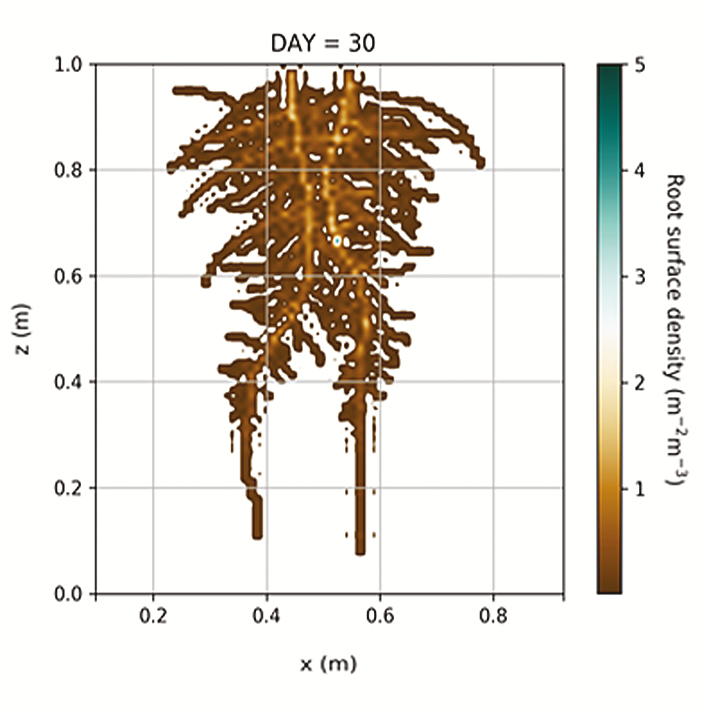
A 3D functional–structural plant (FSP) model including root architecture, airborne plant and reactive transport in the soil was constructed by linking different well-established models. Braghiere et al. describe how soil water availability showed a larger impact on photosynthesis than on carbon allocation and the biomass production in interspecific competition was highly related to rooting depth and plant transpiration. This new model is capable of simulating soil water limitation impacts on plant development and exploring the processes involved in soil–root–shoot–atmosphere interactions. In some of the evaluated cases, water limitation impacted plant growth almost 10 times more than the light environment and biomass production by up to 90%.
Authors: Renato K. Braghiere, Frédéric Gérard, Jochem B. Evers and Christophe Pradal, and Loïc Pagès
Turgor-driven growth in a soybean FSP model
Annals of Botany 126: 729–744, 2020
doi: 10.1093/aob/mcaa076
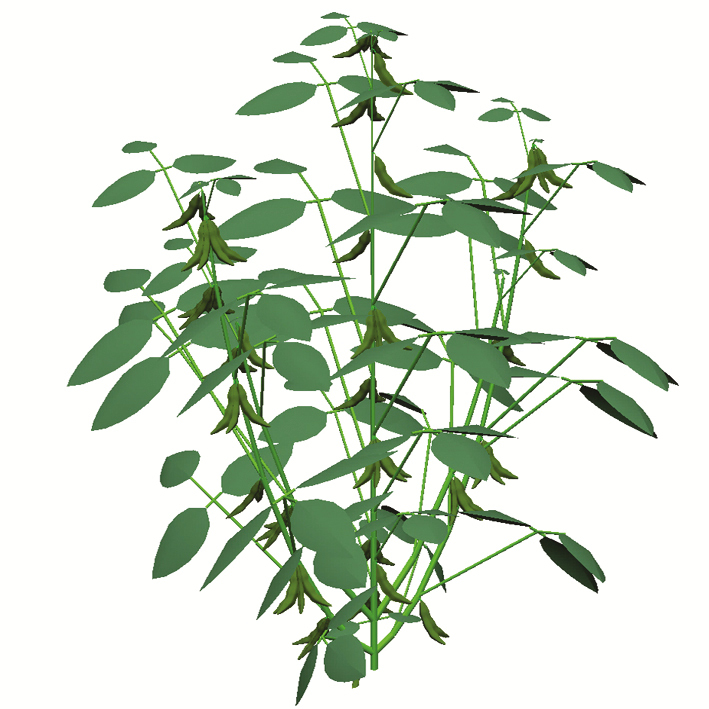
Turgor pressure within in a plant cell lies at the fundamental base of cell expansion. It is directly related to water and soluble sugar availability making it a prime candidate for consideration as part of a mechanistic model for plant growth including the effects of both water and soluble sugars. However, practical application of this approach in full functional–structural plant (FSP) models faces significant challenges which have not yet been thoroughly explored. Coussement et al. presents the first instance of such a model, exploring the possibilities and drawbacks of the modelling approach in a new FSPM for soybean.
Authors: Jonas R. Coussement, Tom De Swaef, Peter Lootens, and Kathy Steppe
A FSP model of mango tree development and fruit production
Annals of Botany 126: 745–763, 2020
doi: 10.1093/aob/mcaa089
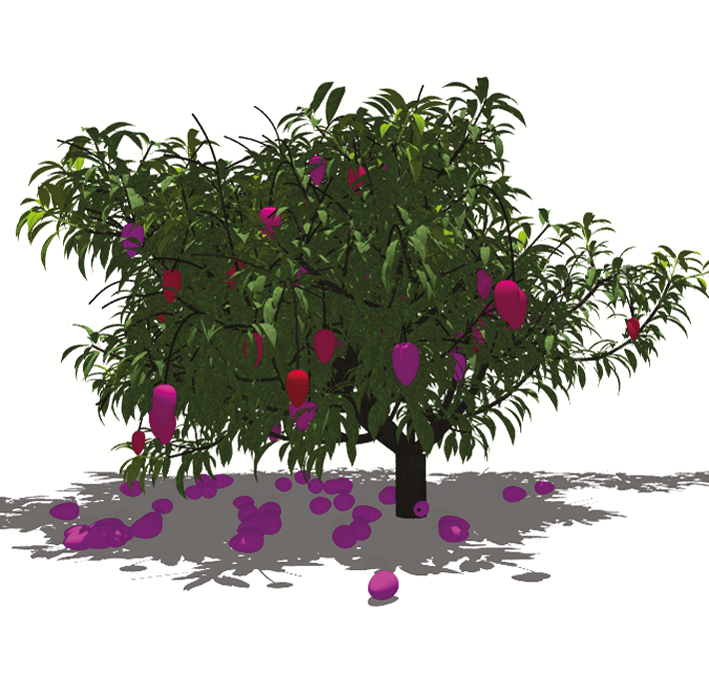
The cultivation of the tropical mango tree (Mangifera indica, Anacardiaceae) is characterized by irregular fruit production across years, heterogeneity of fruit quality at harvest and phenological asynchronisms leading to long periods of susceptibility to pests. Boudon et al. present a functional–structural plant (FSP) model of mango tree development and fruit production, V-Mango, that simulates stochastically the appearance and development of growth units and inflorescences. Individual fruit growth modelling is based on ecophysiological processes. V-Mango allows for a precise characterization of tree phenology and fruit growth and production over several growing cycles, and paves the way for simulating the effects of cultivation practices.
Authors: F Boudon, S Persello, A Jestin, A-S Briand, I Grechi, P Fernique, Y Guédon, M Léchaudel, P-E Lauri, and F Normand
Plant height and leaf area index dynamic by oblique and nadir photography
Annals of Botany 126: 765–773, 2020
doi: 10.1093/aob/mcaa097
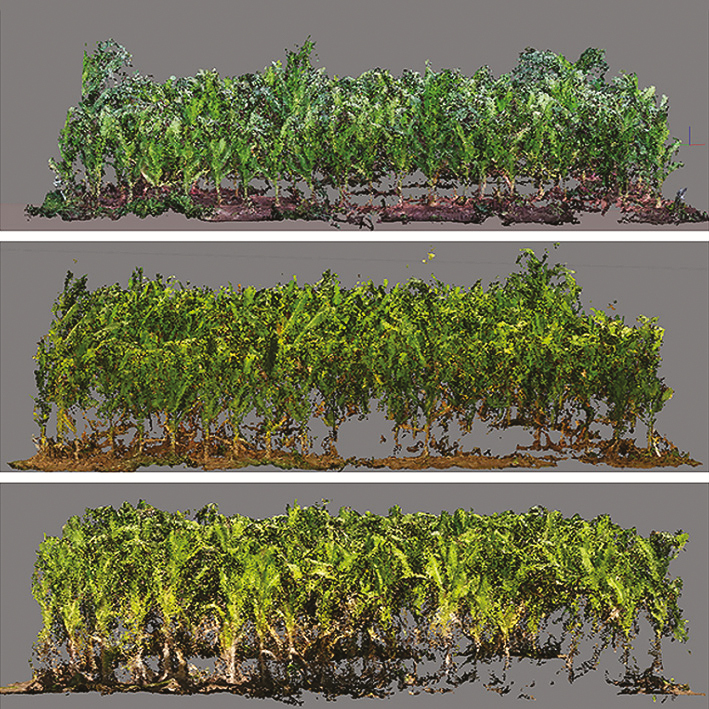
Unmanned aerial vehicle can help to extract plant phenotypic traits rapidly and non-destructively, and with high efficiency. Che et al. evaluate plant height and leaf area index for field grown maize (Zea mays) by oblique and nadir photography. Detailed 3D plant architecture and vertical distribution of leaf area, which are the main indirect traits contributing to yield, were obtained by oblique photography and compared with nadir photography. Oblique photography can obtain intensive point clouds and relatively complete canopy information at relatively low cost.
Authors: Yingpu Che, Qing Wang, Ziwen Xie, Long Zhou, Shuangwei Li, Fang Hui, Xiqing Wang, Baoguo Li, and Yuntao Ma
Modelling tree and fruit growth with different scales of carbon autonomy
Annals of Botany 126: 775–788, 2020
doi: 10.1093/aob/mcaa098

Many experimental studies assume that branches or limbs are autonomous with regard to carbon. Auzmendi and Hanan propose a new method for simulating carbon allocation in the whole tree canopy considering various scales of carbon autonomy, e.g. branchlets, branches and limbs. They implemented this method in a functional–structural plant model (FSPM) for studying the growth of a macadamia tree during one growing season. Simulations using this model were employed to investigate and explain aspects of organ growth variability within the tree, differences in carbon autonomy between trees, tree growth, competition between shoot and fruit growth and time of autonomy.
Authors: Inigo Auzmendi and Jim S. Hanan
3D soil-root modelling to evaluate water and phosphorus uptake by upland rice
Annals of Botany 126: 789–806, 2020
doi: 10.1093/aob/mcaa120
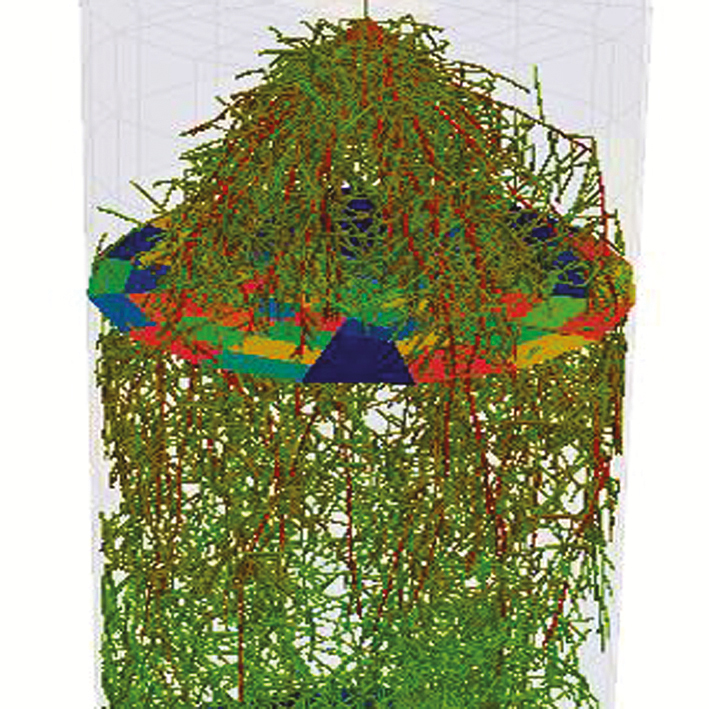
Upland rice is often grown where water and phosphorus are limited. Functional–structural plant (FSP) models representing small-scale nutrient gradients and water dynamics are needed to understand resource interactions and root functioning. De Bauw et al. grew rice in columns at three phosphorus levels and two water regimes. Total water and phosphorus uptake by reconstructed 3D virtual root systems were then simulated by the CRootBox, as FSP model to predict the function of specific roots under contrasting scenarios. Lateral root types and growing root tips are key drivers for phosphorus uptake.
Authors: Pieterjan De Bauw, Trung Hieu Mai, Andrea Schnepf, Roel Merckx, Erik Smolders, and Jan Vanderborght


